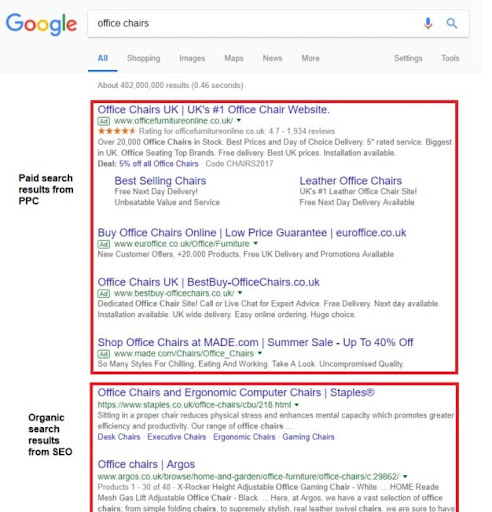There are millions of pages and sites on the internet, but none are more essential to the Digital marketer than SERP(Search Engine Result Page).
Understanding SERP and its complications is crucial for digital marketers aiming to optimize their online presence because more than 92% of the consumer traffic comes to the website from the first search engine results page.
Are you on ranking position on SERP? As SERP is highly competitive since the users are more likely to click on the results at the top and with the launch of Schema, it has become much more complex to predict the user’s needs.
So let’s have a look at how search engines work and what can they do to maximize their online visibility.
SERP- What They Are and How Do They Work
SERPs (Search Engine Result Pages) are online pages served to searchers, like Google or any other search engine when they explore something online. The Searchers enter their keywords or search query, which the search engine provides them with on the SERP.
Each SERP result is unique; even if the search queries are performed simultaneously, the search results are not the same even if you use the same keyword.
This is because the search engine virtually customized the user experience by presenting results based on various factors beyond search terms (keyword), such as physical location, social setting, browsing history, and much more.
You will often see Two SERPs appears as identical same, but will often feature subtitles differently. This appearance of the SERP constantly fluctuates due to experiments done by Google, Bing, and other search engines to provide users more intuitive and responsive experience according to their interests and requirement.
With combined emerging technologies and development in the search space,” Google” SERP today differs significantly from its predecessors in appearance and other factors.
The fact that numerous aspects remain significant for SEO(Search Engine Optimization) is crucial to remember; nevertheless, they should only be considered one part of a comprehensive approach.
Search engines now consider several additional characteristics, such as the quality of a website’s content, the user experience, the speed of the site, its mobile-friendliness, and other factors.
Focusing on producing top-notch content and developing a user-value-oriented website is essential.
Number of Backlinks
The number of backlinks does impact the SERP ranking, but it is just one of the factors that the search engine considers.
The number of external links of the webpages to one specific page significantly determines the SERP ranking. Numerous backlinks to the webpage indicate that the page is authorized on the subject and trustworthy.
Number of Relevant Keywords
Using a comprehensive set of keywords relevant to the subject positively affects the ranking.
While you shouldn’t be confused with Keyword Stuffing, as search engines don’t like it, Google reacts and shares the information on the keywords and phrases that have been searched over time.
User Experience
Content rankings on SERPs consider UX elements, including website loading times, security, and usability.
Trust Indicators
Additionally, search engines consider accumulative information, such as a website’s safety, authority, traffic, and backlinks over time.
People most likely to ask
- What are the parts of SERP?
Basically, SERP consists of three major types of search engine results: Organic Results, sponsored results, “Paid Results,” and Search Queries results with different features like Images, Videos, reviews, ratings, knowledge panels, etc.
- How does the Search engine display results?
When your website is optimized for the key search term, Google will crawl it to establish its relevance for the search term in terms of content, structure, linking, and other factors. This will increase your website’s ranking, traffic, and conversation.
- How does Google know What to show on SERP?
Google search works in three stages, and not all pages make it through each and every stage;
- Crawling
Google download and go through all texts, images, and videos from the page it is found on the internet with an automated program.
- Indexing
Google analyzes the text, image, and video files of the website page and stores the information in the index of Google, an extensive database.
- Serving search results
Whenever the user searches for anything on Google, Google returns the relevant information to the search query.
Types of Search Queries
The SERP displayed after the search depends on the type of search queries entered. Search queries fall into 1 of 3 categories.
Navigational Queries
Navigational queries occur when someone hopes to find a particular website through a search, the individual searching for the specific website, through a URL or any other maritime objective.
But If I don’t search the site with the full URL, it would be challenging to find the search site on the first page of the result. So, take advantage of these queries for your site, and find the correct website.
Informational Queries
It is done when the user wants to learn something, like facts about any particular topic or how to perform specific tasks.
The searcher doesn’t usually look to shop or purchase. Still, the majority of users or searchers use such an informational result, so create the most relevant content that serves your audience’s wants, needs and interests.
Transactional Queries
Individuals create transactional queries when searching for product information or buying something from the board category. Transactional queries have the most revenue potential, so keywords are a must to bid or pay-per-click spots.
The searchers most relevantly see the paid results. Paid Ads are most popular among businesses as they are the most effective. According to research analysis, nearly 70% of clicks on transactional SERP are done on Paid Ads.
TIP: Find the best Keyword and relevant content to fulfil the user’s wants, needs, and interests and better ranking.
Paid Results vs. Organic Results

SERPs typically contain two types of content as their results: Organic Results and Paid Results. Both formats are necessary and equally important to capture customers’ attention and increase traffic, particularly at the beginning of the customer journey.
Paid Ads Listing Results
Paid results are those that have been paid to be displayed on the top by the advertiser. In the past, the paid results were exclusively limited to test-based ones displayed on the right of the organic results.
Nowadays, Google has placed paid ads at the top of the search engine results page (usually displaying 4 ads on the desktop and 3 on Mobile). More than four businesses are competing for the same search keyword.
And paid search results have a little green box with the word “Ad” while listing the company.
For example, the large-text-based ads at the top of the SERP are typically PPC Ads. Of the three, the lower two are Ad extensions and allow future customers to navigate to the specific page on their websites.
The image-based ads on the right of the screen are Shopping Ads, a unique feature offered by the Google Ad platform that allows e-commerce businesses to display alongside other results on SERP.
But to make a decision, Google considers several factors: the bid amount, the quality of the ad itself, and applicability to the search of the users. If Google figures that your site is more suitable than the competition, you will appear top of the page.
Organic Listing Results
Organic Listing earns their place through SEO(Search Engine Optimization), an ever-changing technique used to rank at the top of search engine results or SERP. Organic search results are ones that a search engine’s algorithm and ranking signal favour.
Organic results are ranked at the top based on how well they manage a search algorithm through SEO(Search Engine Optimization).
There is no way you can pay for an organic ranking higher than others. Digital marketing techniques and strategies like SEO and PPC are implemented to improve organic search results.
But besides boosting traffic, show the search engine that your site is trustworthy and authoritative, as there are many benefits of organic listing; it costs money, like paid results, and offers a more substantial ROI.
Ranking Signal and Search/Google Algorithm
The ranking signal is the factor that search engines use to decide the site’s relevance, quality, and authority. These signals help the ranking in search engines and display the most relevant content to the top users based on their search queries.
And as Google is the most popular search engine, with millions of users and sites and pages, it has the most complex algorithm that considers numerous factors of ranking signals to deliver the best possible results.
Some crucial factors for ranking signals which are widely recognized and confirmed by Google include.
Search Engine Optimization(SEO)
Most of the time, users only look at the search engine result’s first four to five pages.
So digital marketers, web designers, content managers, and site owners try SEO strategies in their practice to make their sites/pages appear at the top of SERP.
SEO is used to optimize the facts and information to organically rank on the top page of SERP by limiting the available knowledge about the search engine algorithm and ranking signals.
SERP combines multiple pieces of content, websites/webpages, links, images, etc., and the search algorithm frequently changes, so a strong and Strategic SEO Practice must be determined from them.
The SEO techniques include the following:
On page SEO
Refers to the best practice for content managers to create the best content that is unique, informative, and user-friendly. This includes placement of the most relevant keywords in headings and web page bodies, informative meta descriptions, and optimized User Interface Experience and links. You can even use Content management system tools to manage the content of your website/on-page content.
Off-page SEO
It generally generates links and traffic to your website to boost trust and authoritativeness. Create backlinks via Social Media campaigns, collaborations, partnerships, and much more.
Technical SEO
This includes features such as sitemap, HTTP, and XML schema, all of which provides Google insight and information about site page and content with security.
Covering SEO comprehensively here is impossible; all we need to know is that SEO is the primary factor in achieving rank from organic search perspectives. If you want to understand and learn more about SEO, go through our blog.





